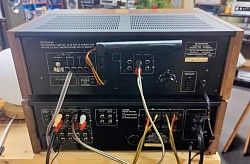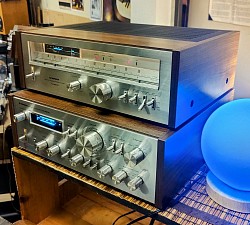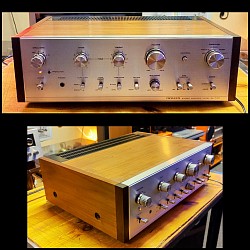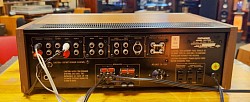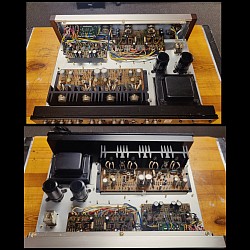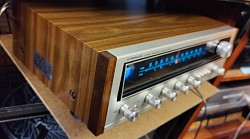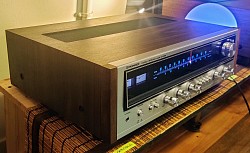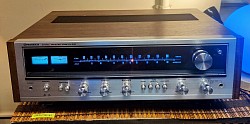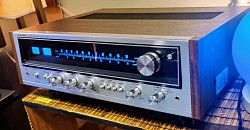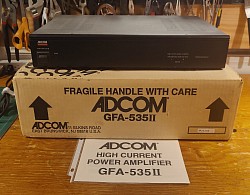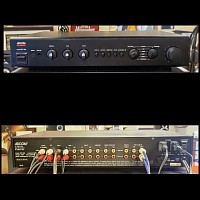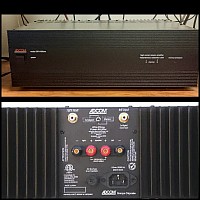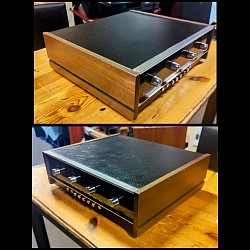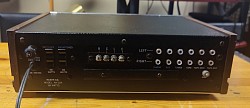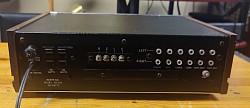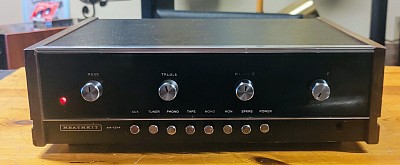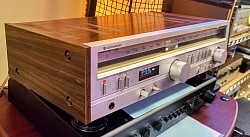Page 2 Vintage Stereo Receivers ~ Tuners ~ Amps
Pioneer SA-8800 & TX-9800
integrated amp ('79-'81) 80 WPC @ 8 ohms / 100 WPC @ 4 ohms
$TBD (sold as set only) includes original boxes & manuals
These are both dual voltage units
This Pioneer SA-8800 was obtained from the original owner. It is in excellent cosmetic condition, fully serviced, fully tested and fully operational. The factory walnut veneer cabinet is included. Also included are the factory documentation (manuals, etc) and the original box with packing materials.
Probably the first thing noticeable (when powered up) would be the beautiful (and stunning) fluoroscan meters along with those massive knobs! The SA-880 is a super fast, super quiet unit featuring Pioneer's "non-switching" amp section.
At a hefty 35 lbs, this SA-8800 was second only to the SA-9800 but was (is) still one of their very best integrated amps built with the current state-of-the-art technology that was available from Pioneer in the late 70's / early 80's. Certainly, along with the SA-9800, this was one of their very best integrated amps of all time.
As per our usual disassembly / deep clean / inspection / reassembly, the servicing also included pots, switches, bias and thorough testing.
Features:
~A protective circuit with a built-in relay is mounted to suppress noise when power is turned on/off.
~Two phono inputs, one of which is capable of level adjustment up to -12dB and 4-point switching of the input impedance.
~The tone circuit is a 2-stage direct-coupled circuit
~The massive volume knob uses a full-scale attenuator type volume with 22 contacts, and uses high-precision printing resistors to reduce gang errors. It also has a 3-step lever type attenuator.
Basic specs:
Power output: 80 WPC @ 8 ohms
100 WPC @ 4 ohms
Frequency response: 5Hz to 100kHz
THD: 0.005%
Dimensions: 17.8"W x 6"H x 16.7"D
Weight: 35 lbs
Pioneer TX-9800 stereo tuner ('79-'81)
Also obtained from the original owner, this Pioneer TX-9800 was the TOTL tuner from Pioneer and was originally considered the perfect mate to the SA-9800 amp. However, it's a bonus to have it matched to the SA-8800 instead. It's also in pristine cosmetic and operating condition. Included are the original factory documentation (manuals, etc) and the original box and packing materials.
The TX-9800, although slightly smaller in dimensions compared to the SA-8800, the TX-9800 is a pure analog unit.
Features:
~the RF amplifier 2-stage front end incorporates a 5-gang variable capacitor and three dual gate MOS FETS.
~capacitance controlled double tuned circuit is inserted between the RF amplifier stages.
Those features produce impressive characteristics such as an IHF sensitivity of 8.8dBf, a spurious response of over 110dB and an image interference ratio of over 120dB.
Specs:
Type: Mono/stereo tuner
Tuning Bands: FM, MW
Tuning Scale: Analog
Sensitivity: 1.5uV (FM), 300uV (MW)
Signal to Noise Ratio: 80dB (FM), 55dB (MW)
Distortion: 0.2% (FM)
Dimensions: 17.8"W x 6.1"H x 15.4"D
Weight: 21 lbs
Pioneer SA-7100
integrated amp ('73-'76) 20 WPC @ 8 / 24 WPC @ 4 $450
Obtained from the original owner, this Pioneer SA-7100 was best described as their "advanced stereo integrated amplifier." In excellent cosmetic condition, it has been extensively serviced, thoroughly tested and is fully operational. It includes the factory walnut veneer case. This particular amp is one of their dual voltage units.
Most of the reviews for the SA-7100 agreed it was "practically overbuilt" considering its modest power rating of 20 watts per channel into 8 ohms (24 WPC into 4 ohms). The superior build quality of this low powered integrated amp basically stumped the competition at first. Everyone scrambled to try and figure out how Pioneer could build this kind of equipment at such a competitive price. It has outputs for two turntables, two auxiliary, two tape PLUS it has jumpers for pre-out/amp as well! That was an incredible amount of features for "just" a 20 watt-per-channel unit.
For those that look at just watts, you'd be missing out on what this superb integrated amp can handle. Features include a 3-stage direct coupled equalizer section, FET equipped tone control amplifier section, turnover frequency selectors and a reliable automatic protection circuit.
Pioneer recommended the SA-7100 in its 1974 catalog as “an extremely user-friendly modern HiFi amplifier”. Additionally, in the case of this model, we cannot forget about the pleasure of use, considering its beautiful simple brushed aluminum panel and high quality knobs and switches.
During its very successful production run, Pioneer could point to the SA-7100 as a perfect example why they were number one in sales during the fiercely competitive 70's (otherwise known as the "Golden Age of HiFi".)
Basic specs:
Power output: 20 watts per channel @ 8 ohms / 24 WPC @ 4 ohms
Frequency response: 7Hz to 80kHz
THDn: 0.5%
Dimensions: 17"W x 6"H x 13.5"D
Weight: 23 lbs
About Pioneer...
Not much needs to be said about Pioneer other then the simple fact that the name is known worldwide for above average quality and excellence in high fidelity component design. They were the unchallenged leader in stereo advertising and marketing in the 70's. Back in the day, Pioneer made it clear that if you didn't have a Pioneer stereo system in your house (or college dorm) you just didn't have the right stuff.
+++++++++++++++++++++++++++++++++++++
+++++++++++++++++++++++++++++++++++++
Pioneer SX-434
('74-'75) 15 WPC $380
In excellent cosmetic and working condition, this Pioneer SX-434 was Pioneer's "budget priced" stereo receiver in the mid-70's. Except for power, it's almost identical to the SX-536, 636, etc of that series.
Features include a beautiful walnut veneer cabinet and the recognizable silver face with Pioneer's famous blue lamps across the FM dial.
Despite it's rated power of 15 watts per channel, it can hold its own in any smaller room. It punches above its power rating and then some.
Technical build features include a high performance FM front end with low noise FET and 3-gang frequency linear variable capacitor...Phase linear ceramic filters and an IC in the FM IF section provide high selectivity of 60dB.
Other features include click stop tone controls, 2 pairs of speaker terminals (if running 2 pairs at the same time, it's recommended to use very efficient 8 ohm speakers), AUX, Tape and headphone socket.
Any way you look at the SX-434, it's just a very nice vintage piece featuring the typical awesome Pioneer quality from the 70's.
Pioneer SX-535
('74-'76) 20 WPC $350
In excellent cosmetic and operating condition, this Pioneer SX-535 Stereo receiver features a low distortion, wide range power amplifier.
Thanks to the use of extra-reliable NPN and PNP silicon power transistors and a differential one-stage, completely and superior frequency characteristics are assured; moreover, the output range and the distortion characteristics are greatly improved.
The differential amplifier circuit and the temperature compensation circuit further ensure that the stability and superior performance of the Receiver are not subject to external conditions, and this adds up to extra stereo listening pleasure for the customer.
High Fidelity Preamplifier
The utilization of the finest components available in the equalizer circuit keeps deviation from the RIAA standards down to a minimum, thereby making an important contribution to the faithfulness of record reproduction.
The 535 is furnished with two sets of speaker terminals on the back panel and the corresponding positions on the speaker selector switch. Thus you can play whatever music you are listening to through two pairs of speaker systems at once, so you can have the same program playing in two separate rooms simultaneously.
The entire design of the SX-535 was carefully thought out with efficient functioning in mind.
As Pioneer stated at the time: "The entirely new-look receiver will fit in with the decor of your listening room perfectly, thanks to its tasteful wooden cabinetry and top quality appearance."
Basic specs:
Power output: 20 watts per channel into 8 ohms
Frequency response: 20Hz to 30kHz
THD: 0.8%
Speaker load impedance: 4 ohms minimum
Dimensions: 18.9"W x 6"H x 16"D
Weight: 22 lbs
+++++++++++++++++++++++++++++++++++++++++
+++++++++++++++++++++++++++++++++++++++++
Adcom GFA-535/II
stereo amp (1993) 60 WPC $300
In near mint cosmetic condition and working perfectly, this Adcom 535/II amp is about as good as it gets for the money spent. It's fully serviced and comes with the original factory owner's manual and box.
When first introduced in 1987, the affordable price (relative to actual performance) was shocking to some in the audiophile community. So much so that it threw some people off; it didn't make sense that an amp of this quality could be so inexpensive when compared to the competition.
True, they did increase the price a few times until the end of production but the mere fact that any models like these could have a successful production run of so many years, in such a hot competitive amp market is still amazing.
While the GFA-535/II is rated at 60 watts per channel, it's built-in headroom puts out more like 80 watts per channel. At this point in time (the mid 80's) it seemed that Adcom's customers wanted Adcom's GFA-555 with 200 watts per channel at $200 more than the GFA-535/II. But did the GFA-555 sound any better? Adcom said "it's our aim to have all our amps sound pretty much the same. You pay more money, you get more power."
Because the markets (and consumers) seem to always need the "new and improved" model, Adcom replaced the GFA-535 with the 535 II. So, how much was it improved? Not much really. The innards and power output are basically the same, a few cosmetic tweaks (mainly the style of the inputs on the back) here and there but, essentially, both versions are excellent.
Stereophile Dec 1987
"The Adcom GFA-535 is one of the finest solid-state amps I have heard. No, not the best; I'm not sure what is the best. But it's an amplifier that is so good for so little money as to be practically a gift. In its price category, the Adcom GFA-535 is not only an excellent choice; it's the only choice. The real question is whether you should buy one even if the cost is much less than you planned to spend for an amp—ie, whether you should put the money into a better CD player or pair of speakers instead."
Specs:
Output power: 60W into 8 ohms
Input sensitivity: 970mV RMS.
Input impedance: 100k ohms.
Frequency response: 10Hz–20kHz, –0.25dB.
S/N ratio: 110dB. (power consumption: 300 watts)
Dimensions: 3"H x 17"W x 11.25"D.
Weight: 19.5 lbs.
Adcom GFP-565
preamp ('89-'98) $500
In perfect operating and cosmetic condition, this Adcom GFP-565 preamp is one of their more highly rated units.
No doubt, the world is filled with excellent, high quality stereo amps but, essentially, they are useless without an equally excellent pre-amp. An amp is merely a chunk of power waiting for the preamp to spread that power in a direct and satisfying manner.
In this aspect, the GFP-565 is a sensible and smart companion to almost any high quality amp. Included is the original factory owner's manual.
The GFP-565 has three sets of outputs: Main (Normal and Lab) and Bypass. Although the tone controls can be switched out of circuit when the preamp is used from its Main outputs, the Bypass outputs omit all the tone control and feature switching and are recommended for the best sound quality.
The GFP-565 can either offer a Class B or a Class C sound, depending on whether its owner wants to use it as a basic, no-frills preamplifier via its Bypass outputs, or as a full-featured control center via its Main outputs.
Basic specs:
Frequency response: 5Hz to 90kHz
THD: 0.0025%
Dimensions: 17"W x 12.5"D x 3.3"H
Weight: 11 lbs
Adcom GFA-555MS
power amp (2011) 200 WPC $600
In perfect operating and cosmetic condition, this Adcom GFA-555ms pumps out 200 watts into 4 ohms.
It takes both unbalanced and balanced inputs and drives your speakers with 125 watts per channel (into 8 ohms) of high performance, ultra low distortion power output all from a neat package.
Technically speaking, Adcom engineered an uncompromised circuit design that delivers ultra-low distortion and a crisp dynamic sound. Great care was taken to ensure that distortion in the 555MS would remain extremely low, particularly when driving these highly reactive loads in which the phase angles of the voltage and the current are substantially different.
Basic specs:
125 watts into 8 ohms
200 watts into 4 ohms
Frequency Resp: @ 1watt, 8-ohms: +0. -0.25dB, 10Hz to 20kHz
Power Bandwidth (-3dB): 10Hz to 100k
Dimensions: 6”H x 17”W x 12.5”D
Weight: 28.6 lbs.
++++++++++++++++++++++++++++++++++++++++
++++++++++++++++++++++++++++++++++++++++
Heathkit AA-1214
integrated amp (1973) 20 WPC @ 4 ohms $150 (partial recap)
Simplicity defined: This Heathkit AA-1214 integrated amp is small in size but, since the power board has been recapped, it's certainly capable of driving most any pair of efficient bookshelf speakers.
It's rated at a nominal 15 watts per channel into 8 ohms and about 20 watts per channel into 4 ohms. All the inputs and outputs are fully functional.
The cosmetics could be better but since part of the lettering over the volume and balance knobs has worn away, it is what it is. Regardless, the faceplate glass, original knobs, real timberwood side panels and textured metal top are all in very good condition.
This is an inexpensive way to get going on a vintage system with the Heathkit providing a solid anchor. As mentioned above, it's all about the right choice of speakers.
Basic specs:
Dimensions: 17"W x 3.9"H x 13"D
Weight: 14 lbs
About Heath...
There once was a time in electronics when you could actually build circuits and equipment yourself. You needed a design that you could create yourself—or if not, get from one of many magazines, including Electronic Design. You could buy the resistors, capacitors, transistors, or tubes in the olden days, then put them all together on a metal chassis, a breadboard, or a finished printed-circuit board (PCB). It was quite a project but doable, and many hobbyists like hams built these designs on a regular basis.
In the late 1940s and 1950s, someone invented the kit business. Companies designed a product and sold it as a bundle of parts called a kit. You could buy the kit for a fraction of what a comparable wired unit would cost and then build it yourself. The outcome was quite favorable—a workable electronic product and a great sense of accomplishment you got from the construction.
Heath was one of those companies that helped start the kit business. Ed Heath founded the company in 1926 with, of all things, an airplane kit. He died in a test flight in 1935, but Howard Anthony kept the company going. Right after World War II, he bought a batch of electronic surplus. Out of that came one of the first successful kits, a small oscilloscope for $50, which was a real achievement in its time. With that success came many new products.
Heathkit probably succeeded more on its ham radio products than anything else. Most of the early kits were shortwave radios, transmitters, accessories like antenna tuners, and the famous Cantenna, a 1-kW non-inductive power resistor in a paint can with mineral oil for the heatsink. Heathkit went on to create an extensive line of small and large transceivers and big power amps, many of which are still operational today.
The Successful Years
Later in the 1950s and 1960s, Heathkit expanded into audio equipment, TV sets, and lots of other consumer products. The company even had a low-cost line of test equipment with scopes, multimeters, generators, counters, and other items. While Heathkit had competitors like Allied Knight, Lafayette, Eico, and a few other smaller companies, it essentially beat the pants off everyone else because it had a better product.
But Heathkit’s good reputation really came from offering a better assembly manual than anyone else. A poorly executed step-by-step manual is a prescription for disaster for any kit company. If the customer can’t build the kit successfully without massive telephone and mail support, it would die a quick death, and many did. Heathkit figured this out early and spent as much development time in the manual as it did engineering the product. Its primary marketing message was “We won’t let you fail,” and the company lived up to it.
+++++++++++++++++++++++++++++++++++++++++
+++++++++++++++++++++++++++++++++++++++++
Kenwood KR-720
receiver (1980) 40 WPC $250(pristine)
Another pristine beauty from Kenwood, this KR-720 is in perfect cosmetic and operating condition.
As the 80's rolled in, most of the Japanese consumer electronics companies began the slow move away from analog into digital gear. Kenwood, like everyone else, began to add digital upgrades while keeping most of the analog "look" (analog tuning dial, silver face/wood case, etc). The KR-720 was part of this transition while also featuring Kenwood's acclaimed "High Speed DC Switching" design.
Rated at 40 watts per channel, the KR-720 has a sleek, slim design with a large distinctive volume knob centered on the brushed aluminum faceplate and mostly simple push/pull buttons. This move to slimmer, slightly smaller receivers seems to have been incorporated by the others as well (Sansui, Pioneer, Hitachi, etc).Built into the circuitry are very cool digital tuning meters and digital FM station finder with LED arrows guiding to perfect station location and lock.
Totally reliable and easy to service, the KR-720 is deceiving because of its size but, make no mistake...it's a powerful and solid design.
Basic specs:
Power output: 40 watts per channel into 8 ohms
Frequency response: 20Hz to 20kHz
THD: 0.03%
Dimensions: 17.4"W x 5"H x 11.7"D
Weight: 17 lbs
Year: 1980
++++++++++++++++++++++++++++++++++++++++
++++++++++++++++++++++++++++++++++++++++

